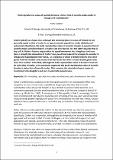Files in this item
Total reproductive value of juvenile females is twice that of juvenile males under X-linkage and haplodiploidy
Item metadata
| dc.contributor.author | Gardner, Andy | |
| dc.date.accessioned | 2021-03-29T11:30:07Z | |
| dc.date.available | 2021-03-29T11:30:07Z | |
| dc.date.issued | 2014-10-21 | |
| dc.identifier | 156249876 | |
| dc.identifier | 63c00384-b3de-40c5-8a55-61e0860af456 | |
| dc.identifier | 000341069600027 | |
| dc.identifier | 84907598658 | |
| dc.identifier | 000341069600027 | |
| dc.identifier.citation | Gardner , A 2014 , ' Total reproductive value of juvenile females is twice that of juvenile males under X-linkage and haplodiploidy ' , Journal of Theoretical Biology , vol. 359 , pp. 236-237 . https://doi.org/10.1016/j.jtbi.2014.06.036 | en |
| dc.identifier.issn | 0022-5193 | |
| dc.identifier.uri | https://hdl.handle.net/10023/21730 | |
| dc.description.abstract | Grafen (2014) has shown that, although the total reproductive value of females is not generally equal to that of males in an age-structured population under diploidy and autosomal inheritance, the total reproductive value of juvenile females is equal to that of juvenile males, provided there is a stable class distribution. It is the latter equality that is key to R.A. Fisher's famous explanation for equal investment into daughters and sons. Here, I simplify the derivation of Grafen's key result and extend the analysis to consider X-linkage and haplodiploid inheritance, i.e. scenarios in which a female receives one set of genes from her mother and one set from her father but where males receive genes only from their mother. I find that, although the total reproductive value of females need not be twice that of males, as is commonly supposed, the total reproductive value of juvenile females is twice that of juvenile males. This recovers the principle of equal maternal investment into daughters and sons in panmictic populations. | |
| dc.format.extent | 2 | |
| dc.format.extent | 106136 | |
| dc.language.iso | eng | |
| dc.relation.ispartof | Journal of Theoretical Biology | en |
| dc.subject | Arrhenotoky | en |
| dc.subject | Reproductive value | en |
| dc.subject | Sex allocation | en |
| dc.subject | Sex chromosome | en |
| dc.subject | Sex ratio | en |
| dc.subject | QH301 Biology | en |
| dc.subject | QH426 Genetics | en |
| dc.subject.lcc | QH301 | en |
| dc.subject.lcc | QH426 | en |
| dc.title | Total reproductive value of juvenile females is twice that of juvenile males under X-linkage and haplodiploidy | en |
| dc.type | Journal item | en |
| dc.contributor.sponsor | NERC | en |
| dc.contributor.institution | University of St Andrews. School of Biology | en |
| dc.contributor.institution | University of St Andrews. Centre for Biological Diversity | en |
| dc.identifier.doi | 10.1016/j.jtbi.2014.06.036 | |
| dc.description.status | Peer reviewed | en |
| dc.identifier.grantnumber | NE/K009524/1 | en |
This item appears in the following Collection(s)
Items in the St Andrews Research Repository are protected by copyright, with all rights reserved, unless otherwise indicated.

